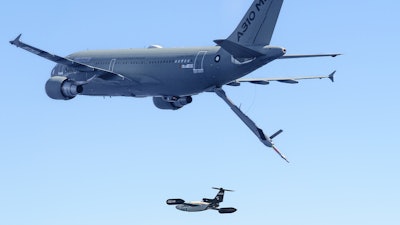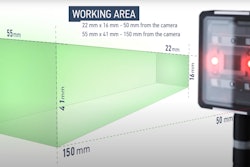
Airbus Defense and Space and the company’s wholly-owned subsidiary, Airbus UpNext, have achieved in-flight autonomous guidance and control of a drone using an A310 MRTT.
In a first step towards Autonomous Formation Flight and Autonomous Air-to-Air refueling (A4R), the technologies demonstrate a significant breakthrough for future aerial operations involving manned and unmanned assets.
These cutting-edge, ‘Made in Europe’ solutions could reduce crew fatigue and the potential for human error, as well as minimizing crew-training costs and providing more effective operations.
“The success of this first flight-test campaign paves the way for developing autonomous and unmanned air-to-air refueling technologies,” said Jean Brice Dumont, Head of Military Air Systems at Airbus Defense and Space. “Even though we are at an early stage, we have achieved this within just one year and are on the right track for manned-unmanned teaming and future air force operations where fighters and mission aircraft will fly jointly with drone swarms.”
Known as Auto’Mate, the technologies were integrated on an A310 MRTT flying testbed, which took off from Getafe, Spain, on 21 March, and on several DT-25 target drones, acting as receiver aircraft and flying from Arenosillo Test Centre (CEDEA) at Huelva, Spain.
Over the waters of the Gulf of Cadiz, the control of the drone transitioned from a ground station to the A310 MRTT, autonomously guiding the DT-25 to the in-flight refueling position.
During almost six hours of flight test, the four successively launched receivers were sequentially controlled and commanded thanks to artificial intelligence and cooperative control algorithms, without human interaction. The different receivers were controlled and guided until a minimum distance of 150 feet (around 45 meters) from the A310 MRTT.
Auto’Mate Demonstrator technology focuses on three pillars:
- Accurate Relative Navigation to precisely ascertain the relative position, speed and attitudes between the tanker and the receiver;
- Intra-Flight Communication between platforms to allow information exchange among the different assets, increasing the autonomy of the system of systems;
- Cooperative Control Algorithms to provide guidance, coordination, consensus and collision-avoidance functionalities to the tanker and the receiver/s.
These pioneering technologies, developed by a European team from Spain, Germany and France, will continue to increase the capability gap among competitors, as well as being re-used in key technological projects, such as the Future Combat Air System (FCAS).
A second campaign is expected towards the end of 2023, exploring the use of navigation sensors based on artificial intelligence and enhanced algorithms for autonomous formation flight. In addition, there will also be two simulated drones flying in the vicinity of the A310 MRTT to demonstrate multi-receiver autonomous operations and collision-avoidance algorithms.






















